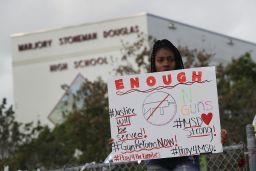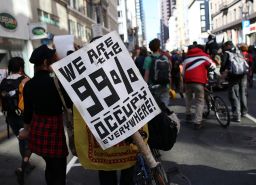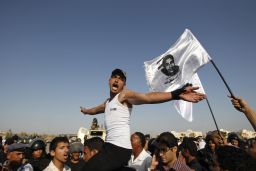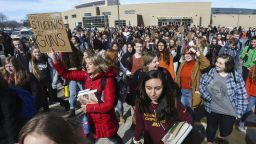They’re just kids. Naïve. Idealistic dupes manipulated by left-wing, gun-control groups.
That’s how some critics are describing the Florida school shooting survivors who have emerged in recent days as impassioned gun control advocates.
But those who’ve led and studied movements describe them this way:
They’re the most formidable foes the NRA will face – and it’s because they’re so young.

After a teenage gunman killed 17 people at their high school in Parkland, Florida, on Valentine’s Day, much of the focus has shifted to the young survivors of the shooting. One author who has covered mass shootings for decades says, “I’ve never seen a phenomenon like these students.” Another praised their “disdain for hypocrisy.”
Yet looming in the background of this praise for the Parkland students is the National Rifle Association’s chokehold on the gun control debate. After virtually every mass shooting in the US, the NRA routinely swats away any calls for more gun control.
What can these kids do to change that? Plenty, say those with experience.
“The NRA is powerful and rich, but there is nothing a strong heart can’t change,” says Trenton Casillas-Bakeberg, a 21-year-old activist who helped launch the One Mind Youth Movement, which took part in the Standing Rock pipeline protests and worked to reduce youth suicides among Native Americans.
“Although they are rich and powerful,” he says of the NRA, “they aren’t going to be powerful forever. It’s going to change – if not now, it will eventually.”
Here are four reasons those who say youth can’t change the gun debate may be wrong.
1: Kids lead and adults follow
Conventional wisdom says grown-ups spark social change and the kids merely follow. When people think of great activists they often picture adults: Nelson Mandela, Cesar Chavez, the Rev. Martin Luther King Jr. Not too many kids in those images.
But if you read between the lines of history books, the opposite is often true, historians say: Kids get out front on issues and it’s the adults who follow.
Young people have been key actors in nearly every major social movement in modern history, says Sasha Costanza-Chock, an associate professor of civic media at MIT.
“Whenever we have had a movement with widespread mobilization through history, young people are at the forefront,” says Costanza-Chock, author of a paper entitled, “You and Social Movements: Key Lessons for Allies.”

A teenager, for example, struck one of the first blows in the civil rights movement.
History books say Rosa Parks kicked it off when she refused to give up her seat to a white person on a segregated bus in Montgomery, Alabama. But it was a teenager, 15-year-old Claudette Colvin, who’d taken the same brave step nine months earlier in the same city, Costanza-Chock says.
The list goes on:
Teenagers confronting water hoses and police attack dogs turned the tide in the 1963 civil rights campaign in Birmingham, Alabama.
Young people drove the Arab Spring protests that toppled dictatorships in Tunisia and Egypt.
Young people in the Occupy Wall Street movement forced millions of America to confront the issue of inequality.
A 23-year-old immigrant, Clara Lemlich, started a strike involving 15,000 factory workers in New York City in the early 20th century that helped spark the modern labor movement.
And young people taking to social media spawned Black Lives Matter.
“It’s going to be an uphill battle,” Costanza-Chock says of the fight for more gun control, “but if anyone can do it, it’s going to be young people.”
2: They have more passion because they pay the price
One of the most memorable moments in the aftermath of the Parkland shooting came when David Hogg, a high school senior, looked into a camera and said:
“We are children. You guys are the adults. Work together, come over your politics, and get something done.”
The moment was so powerful because of the helplessness Hogg expressed. He was saying that his friends literally died because adults failed to act.
That sensibility – we pay the price for adult failures – is another reason some say youth activists can be so motivated. They have to clean up the mess adults leave behind.
Jasilyn Charger, who helped start the One Mind Youth Movement, says youth understand the urgency of now in a way that many adults don’t.

“We understand that we are going to inherit this Earth and its government and its laws,” she says, “so it’s up to us to forge our own path in the future and be proud of it.”
Youth pay the price for adult inaction in other ways. Constanza-Chock, the MIT professor, says there is a “war on youth” that pushes many of them to become impassioned activists.
Many youth of color in particular, Constanza-Chock says, are targeted by stop-and-frisk policies, police brutality and a school-to-prison pipeline that pushes kids more toward incarceration than college.
The kids who survived the Parkland shooting bring a firsthand authority to the gun debate that adults can’t match.
“These students have great moral credibility because they speak as people directly affected by this issue,” Constanza-Chock says. “It’s going to be very hard for an NRA spokesman to dismiss the voice of the students.”
3: They have one resource most adults lack
The NRA is formidable because of the money it can raise but also because of the passion it can summon in its followers, says Kathleen Marchetti, an assistant professor of political science at Dickinson College in Pennsylvania.
Before Parkland, most gun control advocates couldn’t compete with the passion of many NRA members. After each mass shooting, people would demand more gun control. But that activism would wane as time went on and media attention drifted elsewhere. Yet NRA members never tired of reminding lawmakers they’d be voted out of office if they supported gun control..

Youth, though, are equipped to match the stamina and passion of the NRA, some say, because they have one luxury many adults lack: time.
“Young people can have an advantage over someone working full time because they have time to mobilize and to engage in sustained mobilization,” Marchetti says.
That time can be spent on everything from developing strategies and pressuring lawmakers to registering voters and raising awareness, she says.
“The bulk of the power in the NRA does not rest only in their donations but with their ability to mobilize large groups of single-issue voters,” she says. “Money is not typically the deciding factor in changing policy. What’s really going to matter is being able to sustain that activism and keep the pressure up.”
Charger, the youth activist, says movements are ultimately powered by passion, and passion is forged though shared suffering. She says she feels a kinship with the Parkland students because she knows what it’s like to go against people with guns. That’s what her group faced when it participated in protests at Standing Rock, where armed police also deployed tear gas and water hoses against protesters.
“Nothing is too big and powerful – everything man-made breaks, including our laws and the government,” she says. “Everything has a soft part that can be taken down. Nothing is too strong to overcome as long as you have solidarity with everybody around you.”
4: They’re innovators in protest tactics
No matter what happens now, the Parkland shooting survivors already have one impressive accomplishment: They’ve kept the issue of gun control in the media a full week after the shooting.
They’ve done it in part because they grew up with social media. They’ve created their own hashtag, #NeverAgain, gone on Facebook and Instagram, given press conferences – all to keep the issue in the news. They’ve even talked about policy goals and scheduled a nationwide protest, March for Our Lives, on March 24.
“One thing that young people are absolutely great at are recognizing the importance of symbols and imagery and being able to use social media,” says Marchetti of Dickinson College. “They have the upper hand in that regard.”
What Parkland students are doing is following a pattern of previous youth activists: They’re using the latest technology to get their message out, says Costanza-Chock.
Some examples:
In 2006, middle and high school students used MySpace, text messages and film screenings to orchestrate high school walkouts across the US to protest anti-immigration legislation proposed by a Republican congressman.
The next year, youth used blogs and social media to organize protests over the Jena 6 case, in which six black teens were accused of beating a white classmate in a Louisiana town.

And in 2012, they used Facebook and Twitter to demand justice for Trayvon Martin, a black youth shot to death by a neighborhood watch volunteer.
There’s a shrewdness to the Parkland shooting survivors that goes even beyond technology, Costanza-Chock says.
“If you look at their press releases, they’re already starting to circulate lists of elected officials who are going to be in close races in midterms and as people in particular to target,” he says.
Charger, the youth activist, says that even if gun control laws don’t change, the Parkland shooting survivors will.
“When something like this happens to someone, you will never be the same,” she says. “The person you are after this is a completely different person. How that affects you, and the people around you, is up to you.”














